Spend a little time with Paolo Laboa, the executive chef at Solo Italiano in Portland, and you’ll probably discover you’ve been doing pesto all wrong. You’ve been using the wrong basil, or too much basil. You’ve been heavy-handed with the garlic. Or you’re serving the pesto in the wrong way.
But that’s OK. Laboa, 55, considers himself a teacher and is happy to share his family’s pesto recipe and explain the right technique so your summer pesto doesn’t turn out too garlicky or bitter, or with a coarse texture. Since at this time of year, the basil is practically bursting out of the garden, we asked him for a lesson.
Laboa’s pesto alla genovese is velvety smooth and bright pea green. Lightly coating a serving of silk handkerchief pasta (mandilli di seta), it is by far the most popular dish at the Commercial Street restaurant.
At Solo Italiano, diners go through so much pesto – as much as 60 portions a night – the staff must make it in an industrial-sized blender while Laboa’s prized mortar and pestle sits on the shelf. (The pestle, made of the wood of an olive tree and circled with an engraved 24-karat gold band, was the chef’s trophy from the 2008 World Pesto Championship in Genoa.) But Laboa doesn’t worry about abandoning tradition.
“I think 200 years ago, if they had a blender, they’d use a blender,” he jokes.
TO BEGIN WITH, BETTER BASIL
Laboa says he can make better pesto in Portland than he could in California, where he was head chef at Farina in San Francisco. That’s because, he said, “the basil here is proper.” He buys Genovese basil from Olivia’s Garden, and because it is hydroponically grown, it’s available year-round. (You can make it now, and freeze it, too, then serve it on those bitter-cold nights six months from now when summer is just a memory.)
Many people make the mistake of growing basil until it bolts, and those larger, tougher leaves can be bitter or develop either a minty or licorice-like flavor, according to Laboa. The American fascination with big leaves reminds him, he said, of the first time he ordered a lamb in California. When it arrived in his kitchen, he said ” ‘I’m sorry, I ordered a lamb, not a horse.’ ”
Laboa chalks up many of the differences in making pesto in Italy versus America to cultural differences. In America, bigger is better. More is better. As a culture, Americans are always looking to move forward, to improve upon things, and that includes recipes.
In Italy, Laboa said, “We tend to say this recipe is 200 years old. This is the best you can get.”
In Genoa, basil pesto is “very common, Laboa said, and every family has its own recipe. Pesto is served two or three times a week – in soup, on foccaccia and, of course, with fresh pasta.
Laboa’s mother, Edda, started teaching him how to make it when he was 6 years old. She would give him a little cupful of pesto so he could dip bread into it. It became his snack of choice, and it’s a memory that he cherishes. The flavor of his mother’s pesto is “here and here,” he said, pointing to his mouth and his heart.
“It was beautiful,” Laboa said. “It was amazing. Every time my mother made the pesto, I felt the flavor, and emotion. I always said ‘Mama, can you teach me? I want to learn this.’ ”
His mother would reply: “Just watch and try. Watch and try.”
(Laboa is now passing along those lessons to his own daughters, 6-year-old Evelina and 8-year-old Violet. Every Tuesday night, they make gnocchi and pesto together.)
Laboa spent a lot of time learning how to cook in his mother’s kitchen, much to his father’s chagrin – he wanted his boy to go outside and play soccer – but the time the chef spent with his mother and grandmother paid big dividends. By 1992, Laboa had his own little restaurant, called Osteria Genovese, and he had won the title “Best Young Chef in Italy.”
Still, when it came to his pesto, it took Laboa nearly 30 years to get his mother’s approval.
“My mother, she came into the restaurant to eat, and I make the pesto with the mandilli. She tried, and she said ‘Wow, this is better than mine.’ And look, I have goose bumps,” Laboa said, pointing to his right arm. “I almost cried.”
“From there,” the chef added, “I said this is going to be my signature dish.”
Sadly, Laboa’s mother did not live to see her son and his sous chef win the 2008 World Pesto Championship in Genoa. She died that same year at age 87.
SOUS FOR THE ROAD
Laboa’s sous chef at Farina was Danny Bowien, the Korean-American chef who went on to co-found Mission Chinese Food in San Francisco and won a James Beard Award in 2013. Laboa taught Bowien how to make his mother’s pesto. “We made the pesto every day at 5 o’clock together,” Laboa said.
When Laboa was invited to be in the pesto competition, he asked Bowien to come along, and when they arrived in Italy the chef sprung the news that Bowien also would be competing. Bowien, who was the subject of the sixth season of the TV series “The Mind of a Chef,” humorously recalled in episode six what a “surreal experience” it was. The two chefs competed at separate tables, both using Laboa’s family recipe.
“For some reason, I put in too much oil,” Laboa said. “I said, ‘Oh, that’s not 100 percent. I run to him and said ‘Danny, let me see what you’re doing here.’ ”
Bowien’s version was perfect, Laboa recalled. When he was announced as the winner, Bowien dedicated his trophy to his mother and to Laboa’s mother.
The news that a Korean-American had won the contest made a huge splash.
“He got a lot of calls from newspapers: How is it possible a Korean-American can win?” Laboa said. “I said ‘Guys, he’s trained. The recipe is good. At my place in Genoa, everybody came to eat my pesto.’ ”
PESTO IN HIS VEINS
In Genoa, Laboa said, people mostly use basil for pesto, but they may also make a walnut pesto or pignola pesto with just pine nuts, cheese, olive oil, garlic and flavored with a little marjoram. The pine nut pesto is served with corzetti, pasta that’s cut into rounds and stamped with a design.
Mercedes Laboa, the chef’s wife who is a co-owner at Solo Italiano, notes that while Americans put pesto on just about everything, including hamburgers, Italians “have an intention for what it’s going on, or how it’s going to be served.” Italians generally don’t use pesto on meat.
At Solo Italiano, Laboa pairs his basil pesto mostly with fresh pasta and gnocchi. He’ll use pignola pesto on octopus. He has also made dandelion, arugula and kale pesto, which he uses on pizza.
Quality of ingredients clearly counts. As he started on a new batch of pesto in the kitchen at Solo Italiano, Laboa pointed out that he uses only Ligurian extra-virgin olive oil (Genoa is in the coastal region of Liguria) or “regular, pure” olive oil from elsewhere. He offered a few pine nuts for tasting: “Try. They’re very good for you. They’re not Chinese.”
Pine nuts from China – the kind most people buy in the grocery store – are too bitter for pesto, Laboa says. The pine nuts he buys from Micucci’s are almost creamy, and the flavor is rich.

Chef Paulo Laboa’s verdant, velvety pesto alla genovese.
Laboa peeled a clove of garlic and cut it open to remove any green stem inside. He used just one clove for a 2-quart batch of pesto, enough for 36 to 38 portions. One of the biggest mistakes Americans make with pesto is adding too much garlic, he said. Garlic is meant to add a little flavor, like a pinch of salt, not to overwhelm. And the longer it stays in a sauce, Laboa said, the more pungent it will get, so it’s best to use it sparingly.
“He can be roasting an entire lamb leg and uses only half a clove of garlic,” Mercedes Laboa commented.
Laboa tossed pine nuts into the blender in small handfuls, joking “This is my measurement.” He added the garlic and poured olive oil in up to the blades. Then he pulsed the blender until the mixture looked like creamy nut milk. Laboa recommends pulsing the blender instead of letting it run to avoid the machine heating up and changing the flavor and texture of the ingredients. When Laboa is making large batches, he often puts his blender jar in the refrigerator for a few minutes before starting.
Next, he grabbed the basil – which had been soaking in water – by the handful, shaking off most of the moisture before adding the leaves to the blender. A little water on the leaves is OK because it will help to emulsify the pesto. Here’s another place where Americans often go wrong, he said: They stuff too many basil leaves into the blender.
“Imagine you were putting mint in,” Mercedes Laboa said. “You would never overjam it with mint, looking for a certain flavor.”
Laboa added two big pinches of flaky sea salt and pulsed again. “Big salt opens everything,” he said. “It’s the same idea of crushed fresh pepper.”
The cheeses were next – finely grated Parmiagiano Reggiano and Pecorino Sardo from Sardinia, for its “lightly smoky flavor.” Laboa scooped large handfuls of the Parmiagiano Reggiano into the blender, followed by much smaller amounts of the Pecorino Sardo.
Laboa pulsed and tasted, pulsed and tasted, making adjustments here and there. When he decided it was just right, he offered a coated spoon for tasting.
The flavors exploded, saltiness followed closely by the sharpness of the pecorino, all against a background of basil. A taste of his mother’s pesto, Laboa said, is like hearing a melody in your mouth.
“When you eat good pesto,” he said, “it makes you smile.”
Meredith Goad can be contacted at 791-6332 or at:
mgoad@pressherald.com
Twitter: MeredithGoad
Copy the Story LinkSend questions/comments to the editors.


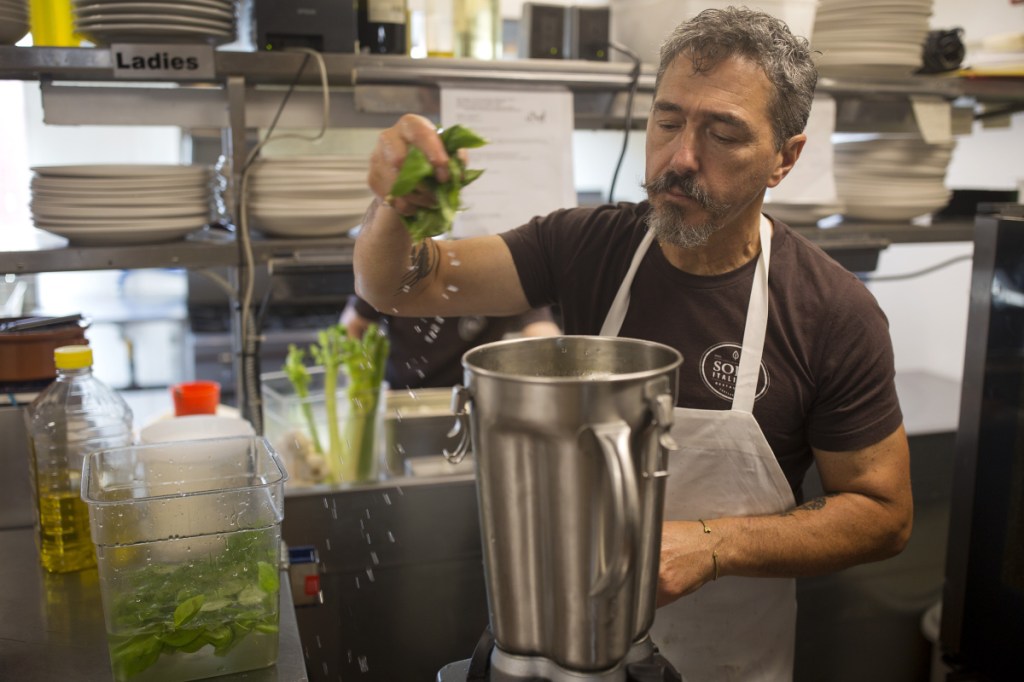
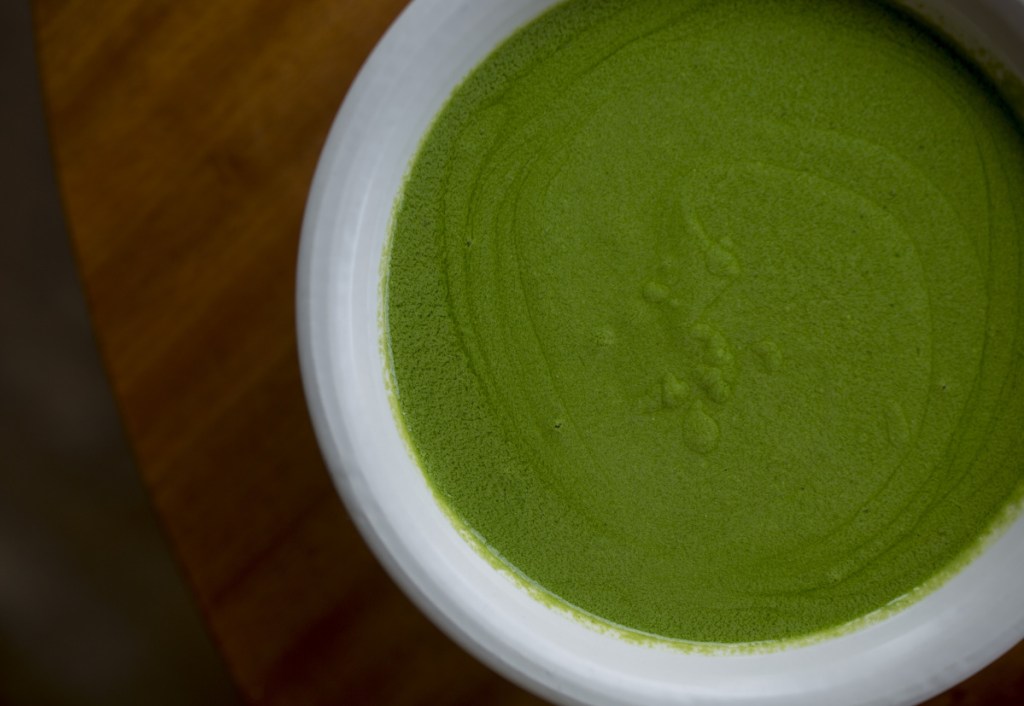
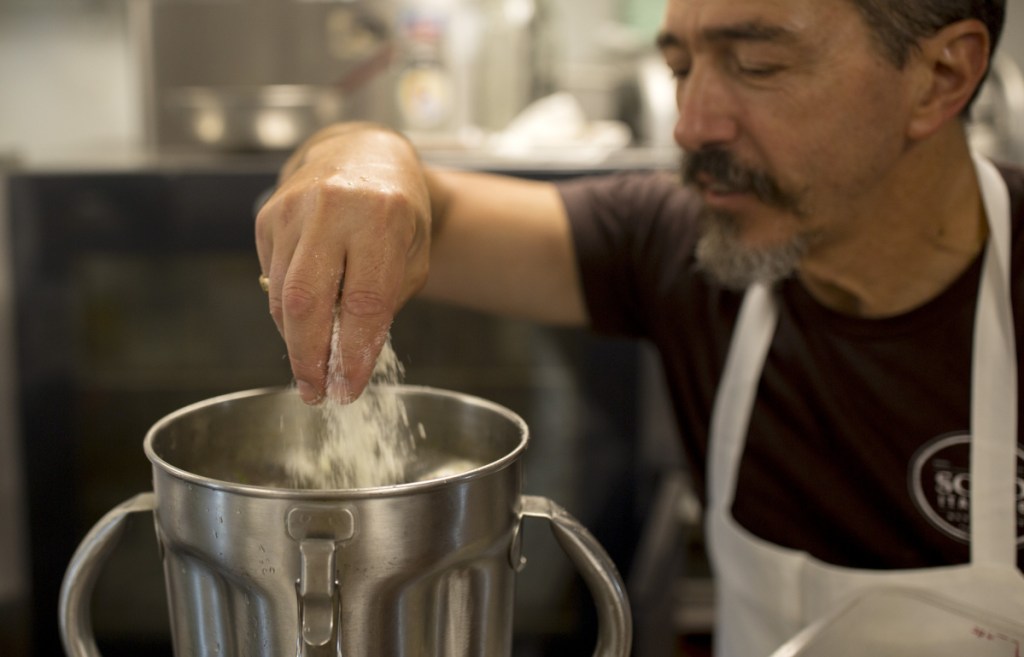
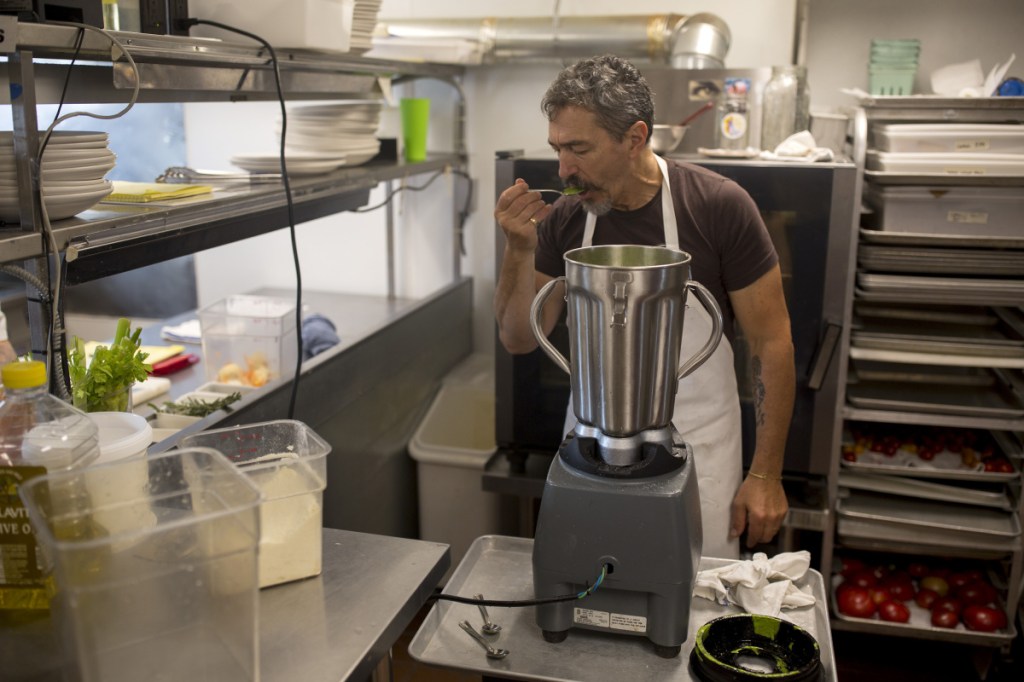
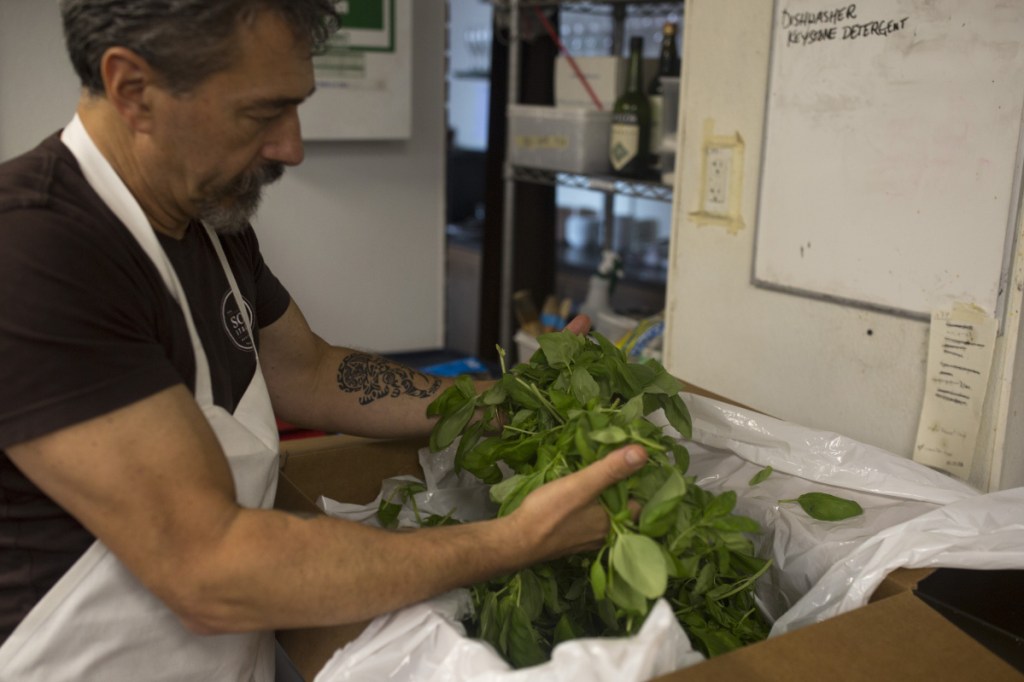
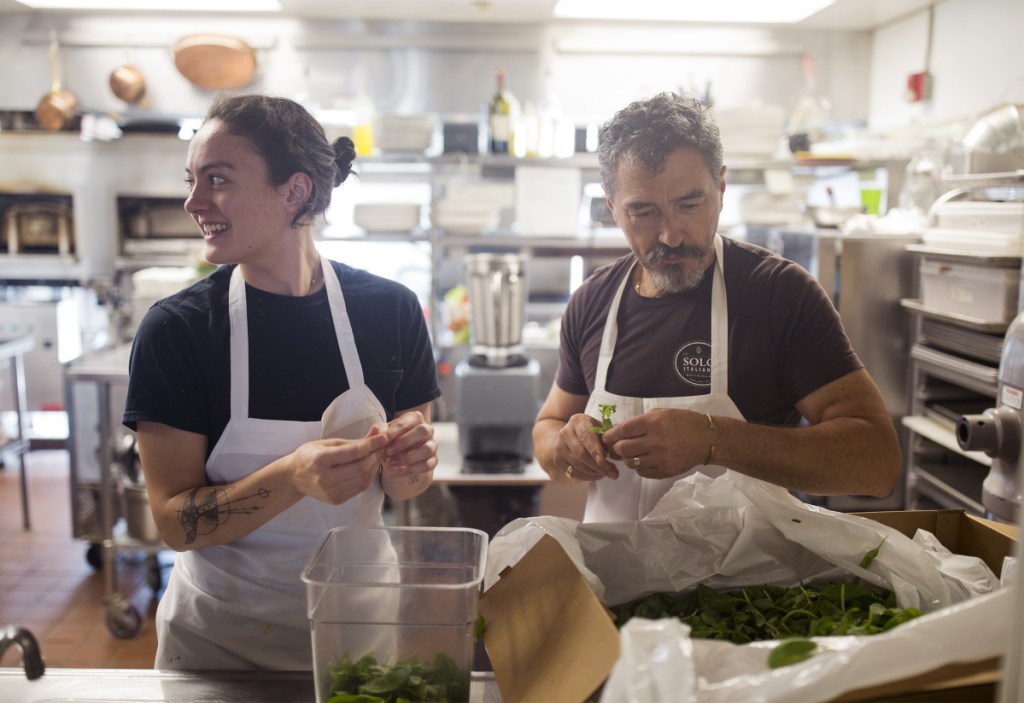

Success. Please wait for the page to reload. If the page does not reload within 5 seconds, please refresh the page.
Enter your email and password to access comments.
Hi, to comment on stories you must . This profile is in addition to your subscription and website login.
Already have a commenting profile? .
Invalid username/password.
Please check your email to confirm and complete your registration.
Only subscribers are eligible to post comments. Please subscribe or login first for digital access. Here’s why.
Use the form below to reset your password. When you've submitted your account email, we will send an email with a reset code.